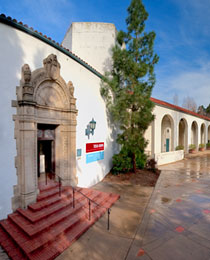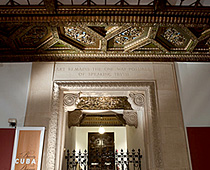Founded in 1925, the Mills College Art Museum (MCAM) is an innovative center of creativity that enriches the Northeastern University Global Network through unique on-the-ground and digital experiences, leveraging technology to erase boundaries, and centering creative voices from across the globe.
With over 12,000 objects, the collection—which is used in exhibitions and loaned to other museums—has significant strengths in works on paper, photography, California and Asian ceramics, and important works by major women artists.
As an academic museum, MCAM is a space for interdisciplinary learning, professional experience for students, and cutting-edge faculty collaborations. Exhibitions are focused primarily on contemporary artistic practices, with an emphasis on commissioning artists to create and exhibit new work designed to engage visitors in critical and creative thinking about the world we live in.
Our History
Mills College was founded in 1852, and by the 1880s, already had 1,000 works of art and reproductions in its collection, as well as 3,000 books in its library. The College’s founders, Susan and Cyrus Mills, had been educated at Mt. Holyoke and Williams Colleges, and both were keenly interested in art and history. Mrs. Mills’ sister, Jane Tolman, was an art historian at Mills who developed an art history curriculum in 1875 that was unique in California and unusually far reaching for its time.
A 1912 bequest from Susan Tolman Mills was augmented by additional gifts, and the present museum building was constructed in 1925. When the museum debuted that same year as the Mills College Art Gallery, it was honored with a large gift of artwork from Albert M. Bender, the College Trustee chiefly responsible for the museum’s completion. This gift of 40 paintings and 75 prints by contemporary San Francisco Bay Area artists became the first public collection of modern art in Northern California. To this day, Bender’s gift remains one of the nation’s most important collections of California regionalist paintings. Bender himself later became a principal founder of what is now the San Francisco Museum of Modern Art.
The museum’s first director, Roi Partridge, was a renowned graphic artist in his own right. Under his directorship (1925–35), the museum became an important center for visual arts on the West Coast. Partridge presented American and European artists, craftspeople, photographers, and designers to Mills students and the greater Bay Area. Among those associated with Partridge’s tenure were sculptor Alexander Archipenko; photographers Ansel Adams, Imogen Cunningham, and Edward Weston; and muralist Diego Rivera.
In the 1930s, the museum began its tradition of collecting, displaying, and studying Asian art in response to the 1928 introduction of Asian art history to the College’s art history curriculum. Major exhibitions of Chinese and Japanese art were held when Alfred Salmony, a distinguished scholar of Chinese art and a refugee from Berlin, taught at Mills in 1934 and 1936.
Alfred Neumeyer, another important refugee scholar, came to Mills from the University of Berlin in 1935 to direct the museum as well as teach art history and museum studies. Neumeyer’s interests focused on modern art and graphics. During his tenure at Mills, the museum featured important exhibitions of modern art, including the first exhibition of Lyonel Feininger’s work in the United States (1936), a major show by Fernand Leger (1941), Lásló Moholy-Nagy and the Bauhaus (1940), and Max Beckmann (1950). For more than 25 years Neumeyer acquired prints that now comprise one of the museum’s most distinguished collections.
During Antonio Prieto’s tenure (1950–67) as a Mills faculty member, the San Francisco Bay Area played an important role in the evolution of ceramics. Prieto amassed a personal collection of extraordinary breadth, including works by Robert Arneson, Viola Frey, Henry Varnum Poor, Peter Voulkos, and Marguerite Wildenhain. After Prieto’s death, artists further contributed to a memorial collection, bringing the total to over 400 works, primarily from Northern California, but also from elsewhere in the United States, England, and Japan. In 1970, the Prieto family donated the collection to the museum.
In 1983, the museum exhibited the distinguished Shojiro Nomura Fukusa Collection, which had been donated to Mills in 1953 by S. Morris Nomura when his daughter, Betty Nomura, attended Mills. Fukusa are traditional Japanese gift covers that date back to the Edo period (1615–1867), and the Mills College Art Museum is home to the largest fukusa collection outside of Japan. The 1983 exhibition, curated by respected researchers Mary and Ralph Hays, marked the public’s second opportunity to view the unique collection.
The museum’s collection continued to grow to over 8,000 objects, building on its strengths in prints and drawings, photography, California paintings, and textiles. In 1998, the gallery officially was renamed the Mills College Art Museum to acknowledge the wide array of exhibitions and programs offered, and its importance as a collecting institution.
Over the next 20 years, the museum hosted exhibitions by renowned contemporary artists such as Jennifer Bartlett, Jay DeFeo, Elizabeth Murray, Mayumi Oda, Faith Ringgold, Miriam Schapiro, Carlos Villa, and Zarina, and group exhibitions including Autobiography: In Her Own Image, True Grit: Seven Female Visionaries Before Feminism, Take 2: Women Revisiting Art History, and We Interrupt Your Program. The museum also has showcased work from the permanent collections in exhibitions such as A Portrait of Mills: Photographs by Imogen Cunningham, California Paintings 1910–1940: Selections from the Mills College Art Museum, and Reverberations: Japanese Prints of the 1923 Kanto Earthquake.
Today, the Mills College Art Museum hosts dynamic exhibitions of contemporary work from nationally and internationally known artists year round.

The Building
The Mills College Art Museum was designed in 1925 by noted California architect Walter Ratcliff Jr. and was the first of several structures Ratcliff designed at Mills while serving as campus architect from 1923 to 1947. The museum, which originally functioned as both a gallery and ballroom, combines the Beaux-Arts Classical and Spanish Colonial Revival architectural styles, featuring decorative ornamentation around doors and windows, a flat tile roof, an asymmetrical shape, and an exterior courtyard.
The original grand entrance to the museum was located at the back of the building and included a trolley stop where visitors could travel between downtown Oakland and Mills. With the construction of the I-580 freeway, this entrance was closed and what had been the back doors that opened onto campus became the museum’s primary entrance and exit. Visitors can still view the original entrance by walking along the Mills College campus trail.
The museum features 6,000 square feet of gallery space in addition to collection and storage areas and administrative offices. The building is made entirely of concrete with a geometrically patterned glass ceiling and skylight that allows natural light to illuminate the artwork.

The façade of the building features Baroque surrounds of carved stone with a quote from Hippocrates inscribed on the front entrance: “Ars Longa, Vita Brevis” (Art is long, life is short). The sentiment further emphasizes the museum’s role in contributing to and upholding the history of art for generations to come.
On the side veranda, the visages and names of renowned artists—including Benvenuto Cellini, Albrecht Dürer, El Greco, Rembrandt Harmenszoon van Rijn, Auguste Rodin, and Diego Velásquez—are carved into eight wooden pillars, representing the creative minds that “hold up” the building. The pillars depict 16 painters, sculptors, and architects spanning the Renaissance to the 20th century. Inside the gallery, on the south wall high above the iron gate, a famous quote from poet Robert Browning is inscribed, reading: “Art remains the only way possible of speaking truth,” reflecting the museum’s mission to inspire research and creative expression through innovative exhibitions, programs, and collections.


